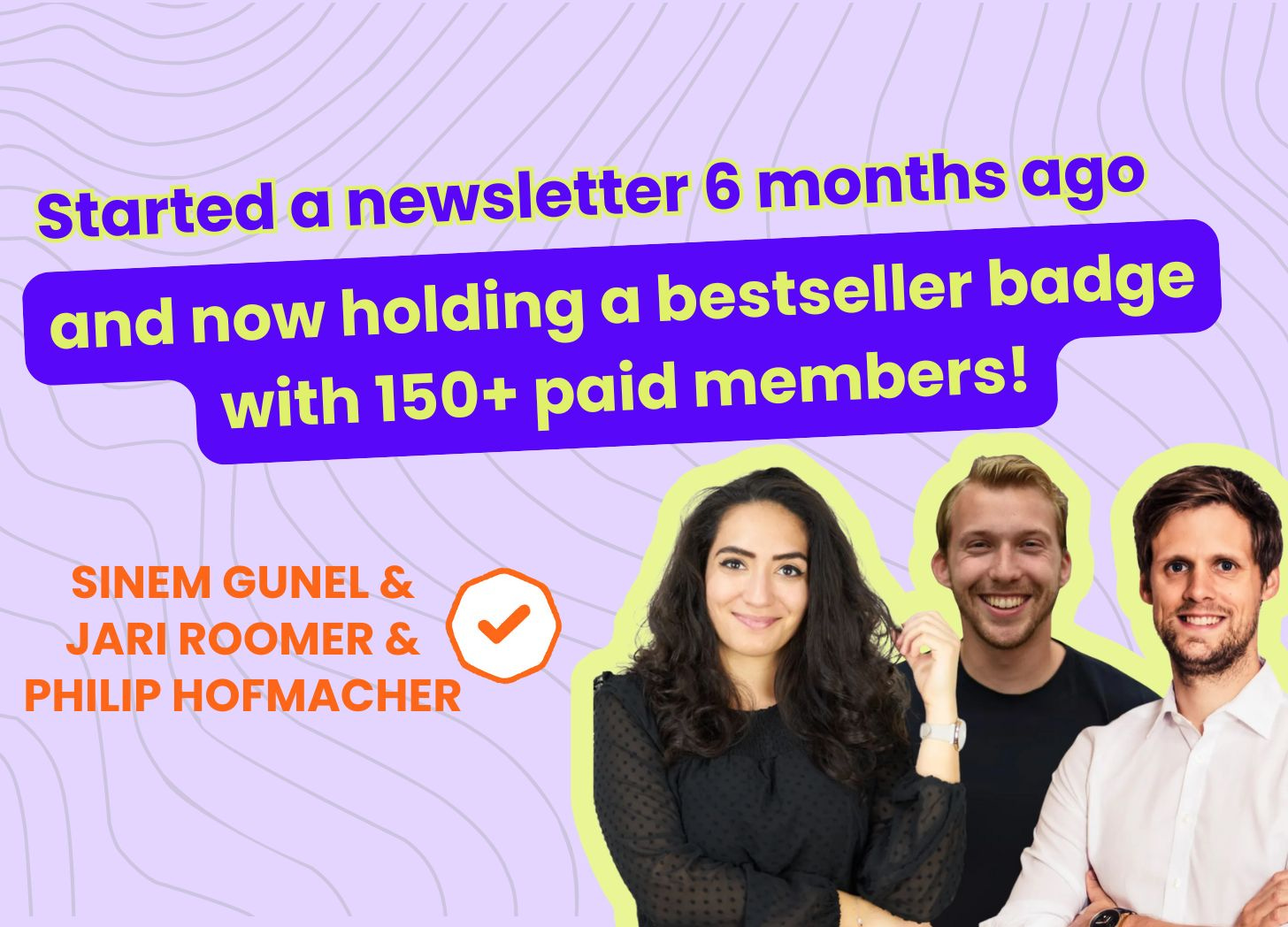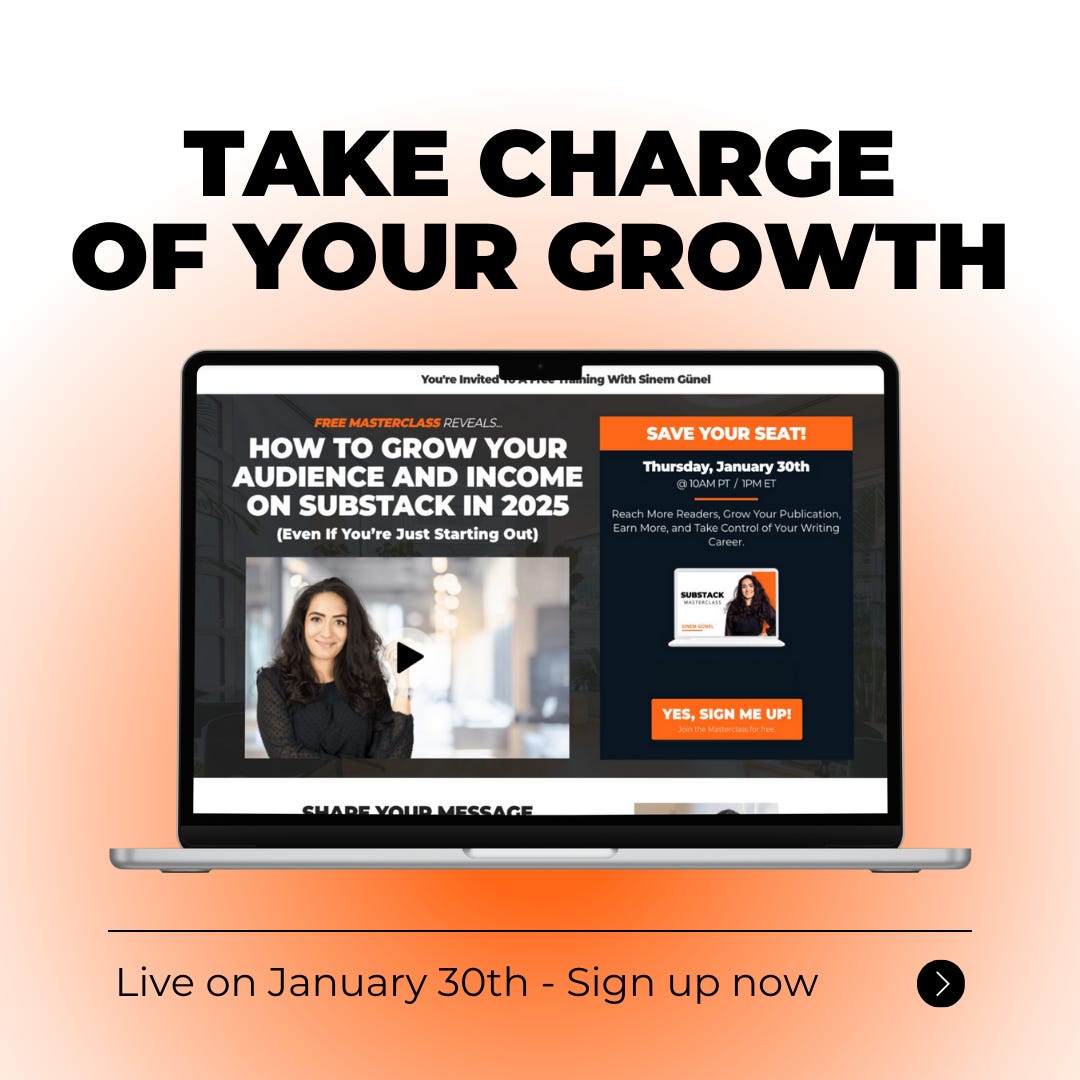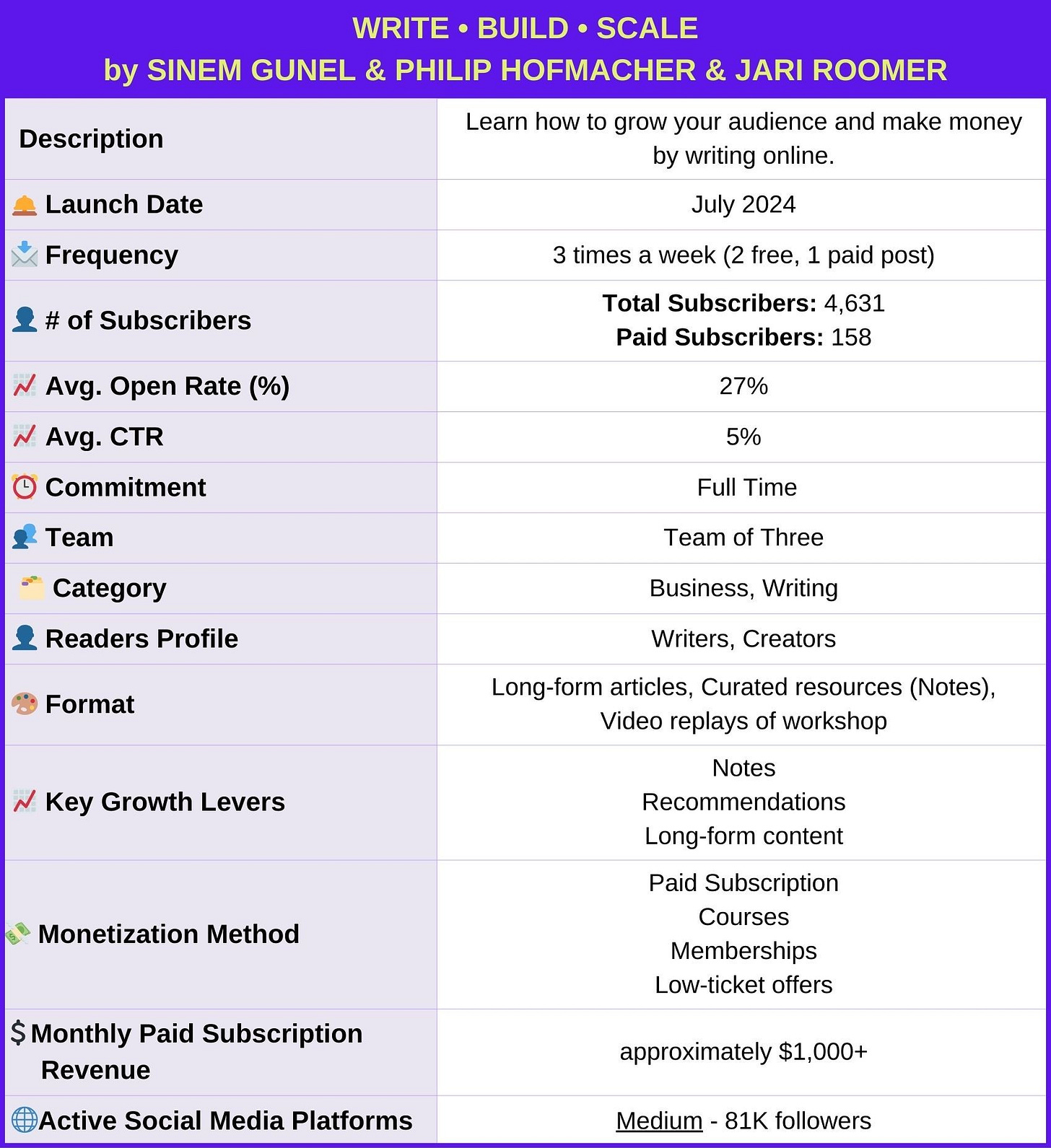Building a Substack bestseller in just two months - Over 150 paid subscribers!
Write • Build • Scale by Sinem Günel, Philip Hofmacher & Jari Roomer
Newsletter Circle is your go-to source for building a successful newsletter business through paid subscription.
👋 MEET THE CREATOR OF THE WEEK
Today, I’m thrilled to welcome , a 27-year-old digital entrepreneur running a thriving six-figure business.
Six months ago, she launched Write • Build • Scale, a Substack newsletter created in collaboration with Philip Hofmacher and Jari Roomer.
Remarkably, they earned a bestseller badge by reaching 100 paid subscribers milestone within just two months! Currently, they have over 150 paid subscribers!
This rapid success wasn’t handed to Sinem—it was the result of years of effort.
She built a vast community long before stepping into the Substack world.
She discovered Medium and its Partner Program in 2018, marking a turning point in her career. Without any prior experience, she immersed herself in the world of writing and quickly uncovered her passion. And today, she has over 80,000 followers on the platform.
After transitioning to full-time writing, her audience and income flourished, attracting numerous writers seeking her guidance. This led to her journey of teaching others how to write and build successful writing businesses.
In addition to her Substack, Sinem and the team also run a newsletter on Kit with over 20,000 subscribers, solidifying her position as a leading voice in the digital writing world.
In our interview, you’ll explore:
Why they started a Substack newsletter alongside their Kit newsletter with 21K subscribers
How they reached 4,600 subscribers through Recommendations and Notes
How they made Write • Build • Scale a Substack bestseller within 2 months
How their newsletter contributes to their 6-figure business
Last but not least, they are hosting a FREE live Masterclass on 30 January where they will share how you can grow and monetize your audience on Substack.
I’m 100% confident that this masterclass will help you big time to make 2025 your breakthrough on Substack.
🏷 NEWSLETTER IDENTITY CARD
⚒️ TOOL STACK
ESP: Substack
Writing: Medium
Task Management: Todoist
Curation & Note taking: Mymind, Raindrop.io, Voicenotes
Design of visuals design: Canva
Webinars: Webinarjam
Digital Products: Sold through Teachable
Affiliate: Teachable
Payments: Teachable
Calls: Zoom
Community: Circle
Video recording: Loom
Welcoming new buyers (for courses & cohorts): Bonjoro
Landing Pages: Clickfunnels
Scheduling: Calendly
Adding events to calendars: Calendarlink
🥁 START
You launched Write • Build • Scale in July 2024 while you’ve been running another one on Kit, reaching over 21K subscribers. Why and how did you decide to start a newsletter on Substack?
I initially launched my first newsletter on Substack in 2020 but left the platform due to the lack of tools like automations, sequencing, and tagging.
“When I reconsidered Substack in 2024, I wasn't searching for a replacement for Kit or Medium.
Kit is an essential tool for us because of various tools that are necessary to run our business and not available on Substack. This includes features like tagging our buyers, automated email sequences, landing pages for our freebies, and more.
Instead, I wanted to leverage an additional channel to reach a new audience and explore short-form writing through Notes.”
— Sinem Günel, Write • Build • Scale
I’d been wanting to explore short-form writing for quite a while, but I couldn't get myself to start writing on LinkedIn or Twitter because I don't enjoy these platforms as a user. Substack Notes seemed like a great alternative.
🚀 GROWTH
Which strategies did you use to grow over 4,700 subscribers in 6 months?
First 1000 subscribers: Many of our initial subscribers had known us from other channels, which made it easy to go from zero to 1,000 subscribers. Even though we never imported subscribers, we did share the launch of our publication with our audience via Kit. (Here’s an example)
Beyond that, there are a few strategies we've relied on so far:
Substack Recommendations: Over half of our current subscribers came in through recommendations. We currently have 191 other writers recommending us. We quickly realized that recommendations can be a huge growth driver and have been excited to build smart partnerships with writers who can recommend our publication.
Substack Notes: Another important factor is Notes. Keep in mind that we’re three writers for Write • Build • Scale, and we all publish several Notes per day, which generate visibility for the publication.
Content Library: We've also built a significant library of long-form content quite quickly. Even though we’ve only been on Substack for 6 months, we have already published more than 80 posts, which are a mix of deep dives, video workshops, and curated content.
Building this library was easy for us because we had a lot of content sitting in our archives, which we just republished.
I’ve published over 600 pieces on Medium since 2018. Many of them have been relevant for our Substack publication as well, and the same is true for my co-founder Jari.
Now, more of our content is original and unique to Substack, but having these extensive archives helped us establish a strong library early on.
"I think many people underestimate this: If someone discovers and loves your Notes, they might follow you, but to subscribe, they must love your long-form content. That's the only valuable metric. Followers won't help you grow a reliable audience or income."
— Sinem Günel, Write • Build • Scale
While you’ve been running a newsletter on Substack, you also have another one on Kit with over 20K subscribers. How do you use these two platforms together?
This has been one of the biggest challenges with Substack. We've talked to dozens of writers about it and no one has fully figured it out yet.
We view Substack more as a long-form content hub than a typical newsletter.
The only newsletter-type post we publish is on Mondays when we curate Notes from our Mastermind members.
On Kit, we run a more typical newsletter with more personal takes, behind-the-scenes insights, and promotions.
We use both tools together by importing our Substack subscribers to Kit, where they go through a short welcome sequence that introduces us and our work. We mention that they’ll now receive our Kit emails as well, so they know what to expect.
Besides the personal touch they receive on Kit, they also get emails regarding our product launches. We aim to keep promotions on Substack to a minimum, but on Kit, we run 2-4 big product launches a year, which now also reach our Substack subscribers.
If someone doesn't want to receive those emails, they can unsubscribe from Kit and still receive all of our Substack posts, and vice versa.
I described this whole process in more detail here.
You have over 80,000 followers on Medium. That’s impressive! Which strategies do you use to convert your Medium followers into newsletter subscribers?
"On Medium, the key is to have a relevant call to action at the end of your articles. If you have various freebies and offers, you can link to them throughout your articles as well. That’s what I do all the time since I have dozens of different freebies for different readers."
— Sinem Günel, Write • Build • Scale
Apart from that, there’s no specific growth strategy on Medium for gaining subscribers. Your priority on Medium is to get in front of readers, and if that works, your job is to have a compelling freebie that fits the article and encourages subscriptions.
You’re hosting a free webinar soon about how to grow and monetize a Substack newsletter. Can you tell us about it?
We’re hosting a free live Masterclass for writers, creators, and newsletter operators to help them grow their audiences on Substack in 2025.
During this training, I’ll share various strategies we’ve used to build a Bestselling publication in less than 60 days, so more people can leverage Substack’s growth opportunities right now.
We’ll talk about:
How to grow your Substack on autopilot,
Why you need to “productize” your Substack,
The foolproof way to launch and grow your paid tier,
And much more!
Registration is now open, click here to secure your spot!
💸 MONETIZATION
Write • Build • Scale became a Substack Bestseller with, having over 100 paid subscribers in a short period of time. How did you gain your first 10 paid subscribers?
Our first paid subscribers came organically through our long-form content. As I mentioned before, we published a lot of long posts right away, which led to our first paid subscribers. This is the dream of any writer: You create content and people discover it organically and happily pay for it. But that’s not the fastest path to growth.
How did you reach over 100 paid subscribers? What are your most effective paid subscriber acquisition channels/strategies?
Going from 10 to 100 subscribers has been a completely different journey.
“We ran a special launch to gain over 100 subscribers within a few days.
Instead of relying solely on our content to convert, we prepared a marketing event. We called it 'Substack September' and hosted several live workshops exclusively for paid subscribers."
— Sinem Günel, Write • Build • Scale
This was the first time we actively promoted our paid tier. We promoted this directly on Substack but also to our Kit newsletter, which made it easy to hit 100 paid subscribers relatively quickly.
Many of them have even been existing clients who had worked with us before and were happy to pay a low annual fee to get access to the publication and all the live events we hosted in September.
So yes, we had an unfair advantage to reach this milestone so quickly, but anyone can use this idea. If you’re starting form scratch, you’ll naturally need more time before you can run a promotion like this because you’ll first have to build up your content catalog and audience, but either way, this will be the most effective path to your first 100 paid subscribers.
What is your biggest learning about applying a successful paid subscription strategy?
"The biggest learning here is that growing a paid tier is easiest when you approach it as a launch and marketing event. It's hard to rely exclusively on your content to convert readers to your paid tier because there is no urgency and no strong reason for them to act and upgrade."
— Sinem Günel, Write • Build • Scale
Even if they love your content, they might not feel the urge to upgrade because, let's be honest, most publications have a lot of free content available anyway.
Usually, you have so much competition that you really need to give your readers a strong reason to upgrade to your paid tier.
We've been running product launches for five years now, so we have a lot of experience in crafting a strong offer, writing compelling copy, and ultimately marketing our products and services, which helped us hit the 100-subscriber mark relatively easily. But the key here is that we recommend anyone approach paid growth with this launch and marketing idea in mind.
How do you use Substack in-platform tools such as Notes and Substack Chat to increase your paid subscribers?
We use Notes and the Chat to promote a monthly workshop that is part of our paid tier. (Here’s an example)
This converts a handful of people every month but is not a huge growth driver. Again, if you want a big chunk of your subscribers to convert to paid, you really have to treat it as a marketing event and give them multiple strong reasons in the form of an irresistible offer and a clear deadline so they upgrade.
📌 IMPACT & LEARNINGS
How did building Write • Build • Scale newsletter contribute to your life professionally and personally?
I have to admit that I completely underestimated how powerful Substack could be for our own business growth.
"When we decided to launch the publication and started to write Notes, I still wasn't 100% convinced that it was the right choice. But it took less than a month to realize that Substack had an incredible potential to be a major platform for us because we get to connect with potential clients much more easily."
— Sinem Günel, Write • Build • Scale
Think of it this way: Your paid subscribers are hot leads for any other offer you might present to them.
We have a lot of different offers and products for writers. If someone is already paying for our Substack publication, they are much more likely to invest in some of those more expensive products with us as well. So the paid tier is like a natural selection process that gives us a clear picture of who our most “valuable” readers are.
What would you do differently if you had a chance to start over Write • Build • Scale?
"I would create a more attractive paid tier right away."
— Sinem Günel, Write • Build • Scale
Most Substack publications say something like “exclusive paid posts” or “access to the full archive” when they're promoting their paid tier.
But if you want to convert readers, you need to give your paid subscribers something extra because nobody really wants to pay for content.
We also hosted a monthly “Roundtable,” where we discussed different topics every month.
The events themselves were great, but calling them Roundtables made them less attractive since subscribers didn’t know what to expect.
We shifted to calling them workshops, and we now have a clear topic and specific teaching points for every single event. This makes it easier to promote the event and also makes the replay much more useful for our subscribers.
What would it be if you had the right to give one piece of advice to aspiring newsletter creators?
"Connect with writers in your niche as quickly as possible. The easiest way to grow your audience is to find them in places where they’re already hanging out. And if other creators trust you, they are much more likely to give you access to their audiences (given that you can deliver value to their audiences, of course)."
— Sinem Günel, Write • Build • Scale
It's basically what you are doing here at Newsletter Circle, right? You are giving creators a stage. But you’ll only offer the stage if you have a track record or if you know and trust them.
Building these relationships isn't always easy when you're starting from scratch, but you can approach it with genuine curiosity. Engage with people's content and think of different ways to add value to them.
If you have an audience of zero subscribers, start with people who have a couple hundred, not with creators who have 10,000 subscribers.
Look for the writers who are similar to you. They don't need to have huge audiences to be powerful collaboration partners for you.
3 Popular Write • Build • Scale Issues
5 Steps To 'Productize' Yourself And Earn $1K - $10K A Month With Your Expertise
How I Launched A Digital Product In 24 Hours (And Made $1,140)
We Built a Bestselling Substack Publication in Less Than 60 Days. Here's the Week-by-Week Breakdown
Where to find Sinem Gunel
ICYMI: The Latest Newsletter Circle Issues
Turning a layoff into paid subscription - Crossplay by Patrick Klepek
From a Hobby Project to a Blog with 100K Monthly Visits + A Paid Newsletter - Analog.Cafe by Dmitri
Thanks for reading, and feel free to reply if you’d like to connect!
See you next Sunday.
Ciler









Thanks for having us at Newsletter Circle! It's been an exciting process to reflect on our own progress and I hope others can walk away with useful takeaways for their own journeys! 🧡